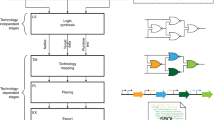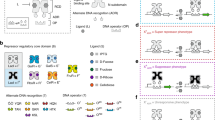Abstract
Genetic programs function to integrate environmental sensors, implement signal processing algorithms and control expression dynamics1. These programs consist of integrated genetic circuits that individually implement operations ranging from digital logic to dynamic circuits2,3,4,5,6, and they have been used in various cellular engineering applications, including the implementation of process control in metabolic networks and the coordination of spatial differentiation in artificial tissues. A key limitation is that the circuits are based on biochemical interactions occurring in the confined volume of the cell, so the size of programs has been limited to a few circuits1,7. Here we apply part mining and directed evolution to build a set of transcriptional AND gates in Escherichia coli. Each AND gate integrates two promoter inputs and controls one promoter output. This allows the gates to be layered by having the output promoter of an upstream circuit serve as the input promoter for a downstream circuit. Each gate consists of a transcription factor that requires a second chaperone protein to activate the output promoter. Multiple activator–chaperone pairs are identified from type III secretion pathways in different strains of bacteria. Directed evolution is applied to increase the dynamic range and orthogonality of the circuits. These gates are connected in different permutations to form programs, the largest of which is a 4-input AND gate that consists of 3 circuits that integrate 4 inducible systems, thus requiring 11 regulatory proteins. Measuring the performance of individual gates is sufficient to capture the behaviour of the complete program. Errors in the output due to delays (faults), a common problem for layered circuits, are not observed. This work demonstrates the successful layering of orthogonal logic gates, a design strategy that could enable the construction of large, integrated circuits in single cells.
This is a preview of subscription content, access via your institution
Access options
Subscribe to this journal
Receive 51 print issues and online access
$199.00 per year
only $3.90 per issue
Buy this article
- Purchase on Springer Link
- Instant access to full article PDF
Prices may be subject to local taxes which are calculated during checkout





Similar content being viewed by others
References
Khalil, A. S. & Collins, J. J. Synthetic biology: applications come of age. Nature Rev. Genet. 11, 367–379 (2010)
Lucks, J. B., Qi, L., Mutalik, V. K., Wang, D. & Arkin, A. P. Versatile RNA-sensing transcriptional regulators for engineering genetic networks. Proc. Natl Acad. Sci. USA 108, 8617–8622 (2011)
Anderson, J. C., Voigt, C. A. & Arkin, A. P. Environmental signal integration by a modular AND gate. Mol. Syst. Biol. 3, 133 (2007)
Wang, B., Kitney, R. I., Joly, N. & Buck, M. Engineering modular and orthogonal genetic logic gates for robust digital-like synthetic biology. Nature Commun. 2, 508, http://dx.doi.org/10.1038/ncomms1516 (2011)
Danino, T., Mondragon-Palomino, O., Tsimring, L. & Hasty, J. A synchronized quorum of genetic clocks. Nature 463, 326–330 (2010)
Basu, S., Mehreja, R., Thiberge, S., Chen, M. T. & Weiss, R. Spatiotemporal control of gene expression with pulse-generating networks. Proc. Natl Acad. Sci. USA 101, 6355–6360 (2004)
Purnick, P. E. & Weiss, R. The second wave of synthetic biology: from modules to systems. Nature Rev. Mol. Cell Biol. 10, 410–422 (2009)
Canton, B., Labno, A. & Endy, D. Refinement and standardization of synthetic biological parts and devices. Nature Biotechnol. 26, 787–793 (2008)
Galan, J. E. & Collmer, A. Type III secretion machines: bacterial devices for protein delivery into host cells. Science 284, 1322–1328 (1999)
Galan, J. E. & Curtiss, R. Cloning and molecular characterization of genes whose products allow Salmonella typhimurium to penetrate tissue culture cells. Proc. Natl Acad. Sci. USA 86, 6383–6387 (1989)
Darwin, K. H. & Miller, V. L. Type III secretion chaperone-dependent regulation: activation of virulence genes by SicA and InvF in Salmonella typhimurium. EMBO J. 20, 1850–1862 (2001)
Mavris, M., Sansonetti, P. J. & Parsot, C. Identification of the cis-acting site involved in activation of promoters regulated by activity of the type III secretion apparatus in Shigella flexneri. J. Bacteriol. 184, 6751–6759 (2002)
Walker, K. A. & Miller, V. L. Regulation of the Ysa type III secretion system of Yersinia enterocolitica by YsaE/SycB and YsrS/YsrR. J. Bacteriol. 186, 4056–4066 (2004)
Thibault, J., Faudry, E., Ebel, C., Attree, I. & Elsen, S. Anti-activator ExsD forms a 1:1 complex with ExsA to inhibit transcription of type III secretion operons. J. Biol. Chem. 284, 15762–15770 (2009)
Temme, K., Zhao, D. & Voigt, C. A. Refactoring the nitrogen fixation gene cluster from Klebsiella oxytoca. Proc. Natl Acad. Sci. USA 109, 7085–7090 (2012)
Kelly, J. R. et al. Measuring the activity of BioBrick promoters using an in vivo reference standard. J. Biol. Eng. 3, 4 (2009)
Tan, C., Marguet, P. & You, L. Emergent bistability by a growth-modulating positive feedback circuit. Nature Chem. Biol. 5, 842–848 (2009)
Arkin, A. Setting the standard in synthetic biology. Nature Biotechnol. 26, 771–774 (2008)
Harold, A. et al. Amorphous computing. Commun. ACM 43, 74–82 (2000)
Katz, R. H. & Borriello, G. Contemporary Logic Design (Prentice Hall, 1994)
Mangan, S. & Alon, U. Structure and function of the feed-forward loop network motif. Proc. Natl Acad. Sci. USA 100, 11980–11985 (2003)
Hooshangi, S., Thiberge, S. & Weiss, R. Ultrasensitivity and noise propagation in a synthetic transcriptional cascade. Proc. Natl Acad. Sci. USA 102, 3581–3586 (2005)
Cookson, N. A. et al. Queueing up for enzymatic processing: correlated signaling through coupled degradation. Mol. Syst. Biol. 7, 561 (2011)
Clancy, K. & Voigt, C. A. Programming cells: towards an automated ‘Genetic Compiler’. Curr. Opin. Biotechnol. 21, 572–581 (2010)
Del Vecchio, D., Ninfa, A. J. & Sontag, E. D. Modular cell biology: retroactivity and insulation. Mol. Syst. Biol. 4, 161 (2008)
Gibson, D. G. et al. Enzymatic assembly of DNA molecules up to several hundred kilobases. Nature Methods 6, 343–345 (2009)
Marlovits, T. C. et al. Structural insights into the assembly of the type III secretion needle complex. Science 306, 1040–1042 (2004)
Temme, K. et al. Induction and relaxation dynamics of the regulatory network controlling the type III secretion system encoded within Salmonella pathogenicity island 1. J. Mol. Biol. 377, 47–61 (2008)
Acknowledgements
C.A.V. is supported by Life Technologies, Defense Advanced Research Projects Agency Chronicle of Lineage Indicative of Origins (DARPA; CLIO N66001-12-C-4018), the Office of Naval Research (N00014-10-1-0245), the National Science Foundation (NSF; CCF-0943385), the National Institutes of Health (AI067699) and the NSF Synthetic Biology Engineering Research Center (SynBERC; SA5284-11210). The content of the information does not necessarily reflect the position or the policy of the Government, and no official endorsement should be inferred.
Author information
Authors and Affiliations
Contributions
T.S.M. designed and performed the experiments, analysed the data, developed the computational models and wrote the manuscript. C.L. developed the computational models. A.T. analysed the data. B.C.S. performed experiments. C.A.V. designed experiments, analysed the data, developed the computational models and wrote the manuscript.
Corresponding author
Ethics declarations
Competing interests
The authors declare no competing financial interests.
Supplementary information
Supplementary Information
This file contains Supplementary Text and Data, Supplementary Tables 1-5, Supplementary Figures 1-18 and Supplementary References – see Supplementary Contents page for further details. (PDF 961 kb)
Rights and permissions
About this article
Cite this article
Moon, T., Lou, C., Tamsir, A. et al. Genetic programs constructed from layered logic gates in single cells. Nature 491, 249–253 (2012). https://doi.org/10.1038/nature11516
Received:
Accepted:
Published:
Issue Date:
DOI: https://doi.org/10.1038/nature11516
This article is cited by
-
Internet of Bio-NanoThings privacy: securing a multi compartmental targeted cancer drug delivery scheme
Multimedia Tools and Applications (2024)
-
A blueprint for a synthetic genetic feedback optimizer
Nature Communications (2023)
-
Trumpet is an operating system for simple and robust cell-free biocomputing
Nature Communications (2023)
-
Synthetic circuits based on split Cas9 to detect cellular events
Scientific Reports (2023)
-
Customizing cellular signal processing by synthetic multi-level regulatory circuits
Nature Communications (2023)
Comments
By submitting a comment you agree to abide by our Terms and Community Guidelines. If you find something abusive or that does not comply with our terms or guidelines please flag it as inappropriate.



